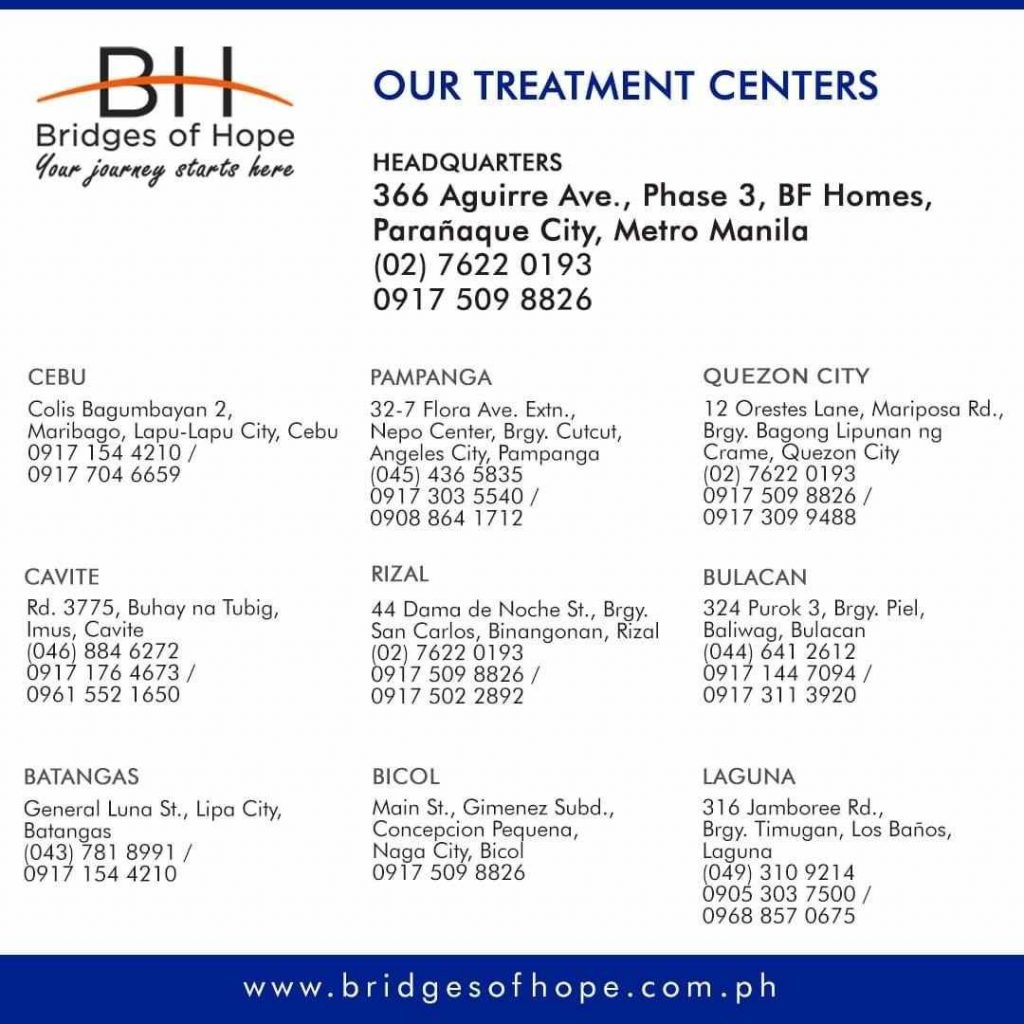How This Architect Builds Hope & Rebuilds New Lives
Joanne Rae M. Ramirez | HS 1979

Lisa Mapua: Building bridge of Hope
During one of our class reunions, my classmate Lisa Mapua politely refused a glass of wine during one happy hour we shared. Hmm, was she pregnant in our mid-life? Lisa adamantly insisted she wasn’t expecting — she was training to run a rehab center for substance abuse and that was one requirement.
But giving up alcohol was perhaps the smallest sacrifice for Lisa, an architect by profession, a mall manager by occupation, and a mother by choice.
Above all else, motherhood was her life’s calling and it brought her to her mission in life — to save the Robert Downeys in our midst so that they, too, can live again in the fullest sense of the word. Just like her own daughter, Monica.
ADVERTISING
Lisa resolved to be the architect of the rebuilding of many lives that were broken by substance abuse. Though it takes more than an architect to rebuild a home or a life — Lisa wasn’t afraid to go into the drawing board. She is a builder, after all. Why not build a bridge to hope, this time?
At the inauguration of Bridges of Hope Pampanga in June are (from left) Bridges of Hope senior program director Gimo Gomez, Bridges of Hope Pampanga executive director Lisa Mapua, Angeles City Vice Mayor Bryan Matthew Nepomuceno, lawyer Erika Nepomuceno and Bridges of Hope-BF Parañaque executive director Robert ‘Jon’ Ty. Photo from bridgesofhope.com.ph
This is her story:
Three years ago, I was at my wit’s end. My daughter Monica was on a very self-destructive path and I knew that if I did not intervene, she would be dead. She agreed that she needed help and that rehab might be the answer. So, we researched and tried to find an appropriate rehab facility in Angeles City, where we live. We widened our search to Bataan and Bulacan, and then cast our net wider until we found Bridges of Hope (BOH) in BF Parañaque. As soon as we entered the BF facility, we knew that was it. This was the place. Bridges of Hope utilizes an eclectic Therapeutic Community approach, which allows tailoring of the program to the needs of the resident and can address addiction to drugs, alcohol, gambling, or dysfunction. It provides a highly structured program that allows people to live together as a form of therapy. Within this community, residents can safely explore their addiction triggers, discover coping mechanisms, and learn to be true to their selves, their families, their communities, and to God.
Residents are assigned chores, and participate in workshops, counselling, therapy, Bible study. All of these, we felt, my daughter needed in order to recreate herself into the “New Monica.” Of course, this is all predicated on the fact that each person has the capacity to grow and to change. Some, however, are just lost in the fog of their addictions and dysfunctions, and must be taught how to change and guided through their growth. Yes, I do believe that within every substance abuser is a potentially brilliant Robert Downey Jr., waiting to be set free and to shine under a new light. Every person has value and must be defined not by his addiction. He is not his addiction. But the road to recovery is never smooth, so Bridges of Hope offers lifetime aftercare. Program completionists are welcome to return, to refresh, to participate in wholesome outings and activities. They need to keep the center and the counselors as their touchstones for sobriety and a new life. I did not see my daughter for several months. I realized that we both needed this space to recover from years of stress. I was so appreciative that as difficult as she could be, her counselors never gave up on her, and kept me updated on her progress. Knowing that she was safe in the center allowed me to rejuvenate and rediscover the fun side of me that had been lost for so long. I am so grateful to my friends and family who supported with their love, concern and kindness through the years. One of them told me something I will never forget: “It takes a strong person to ask for help.”
As my daughter progressed through the program, I had to make weekly visits to the Bridges of Hope BF Center, at times driving five hours one way from Angeles City, mostly due to the traffic in Metro Manila. I would often tell the executive director Robert “Jon” Ty that he should put up a BOH center in Angeles City. They already had two campus branches, BF and another one in New Manila, Quezon City and they were opening another in Cebu. He told me to do it: “Open one in Angeles! We’ll support you!” I prayed about it and asked the Lord: “If this is your new mission for me, then you will help me make it happen. Show me the way.” And He did…magnificently! Everyone I encountered in this journey to establishing Bridges of Hope Angeles has been kind, generous, helpful, and everything I needed popped up just when I needed it. He kept sending me such powerful signs that I simply could not ignore His will. It strengthened my resolve in my mission and I proceeded with a passion for this “turning lemons to lemonade” project.
I set my sights on finding a site. I realized that if you want the families to actively participate in the rehabilitation, then the location must be convenient for them. I found an abandoned grade school campus in a quiet section of a bustling commercial district and I thought the large classrooms with high ceilings were perfect! Being an architect, I worked with my contractors, also architects, to plan the zones, renovate the rooms, find the right balance between safety and security and ease of operations. And nine months after signing with BOH, we were ready to open and accept our first residents, many of whom are from the provinces north of Manila. So, three years after my daughter first entered rehab, we come full circle and have transformed what is possibly the most negative part of our lives into something positive. She and I are now ready to give back and help other families who may have felt as hopeless as we did three years ago. The big thing that transformed our lives is that we really did find and cross over that Bridge to Hope.
PROLOUGE… In Liza’s own words
I am always grateful to ACHS79 classmate Joanne Ramirez for featuring my story in 2017. That was almost 6 years ago. As I said then, recovery is a process and not always a smooth one. Yes, it can get bumpy, but one must never lose sight of the vision of what your life could be so you can make strategic moves to make it so. So here’s an update on us and our “lemons to lemonade” story since then.
My daughter Monica lost over 100 lbs. and graduated 12th grade with honors. She is now a college student on the Dean’s List majoring in Marketing Management. We have a smooth and healthy relationship now, coordinating our busy lives and household needs. She has a daughter Olivia, born during the pandemic. Olivia is our “Joy Machine” and she has given Monica a purpose and meaning to her life. I am amazed at what a responsible, loving, and caring mother “New Monica” has become. Like her mother who was once a swimming champion, Olivia loves the water and at 2, is the youngest student in her Tadpole Class.
I was promoted to president with more malls added to my management portfolio, all the while still running Bridges of Hope Angeles as executive director. I will take my retirement in November, after 21 years running malls. It is a delayed retirement because I could not leave the company in the midst of the pandemic and had to see all the malls I managed safely on the path to recovery. It has been a good run, and I am grateful for working with people who have been by my side for 10, 20 years.
Bridges of Hope has grown and has 10 branches nationwide, all accredited by the Department of Health. Teamwork and guidance from our counselors, medical teams, and advisors were essential for all the branches to weather the pandemic and the difficult logistics and protocols that Covid 19 presented. Soon, I will be opening another Bridges of Hope in Tarlac. Together, all the centers of Bridges of Hope have helped so many families weighed down by addiction and dysfunction. All of the BH centers are owned and staffed by our graduates. It’s our way of giving back but not giving in. I am for grateful for taking the first steps over that bridge to hope many years ago, and continued on that journey even if sometimes bumpy. What’s it like on the other side of the bridge? Life is just great!





AMEN!!! Im so blessed…
Tita Lisa, i am Aischa Gomez from Baguio, daughter of Pynky Hizon Gomez, i think we are related somehow…
My son, Raf has been struggling with cannabis addiction since 2018 and it triggered his bipolar disorder…hes been in and out of local rehabs, and the therapeutic meds dont work in the long haul. We found BH Paranaque through a friend of my moms, and Raf has been inside since April this year…hes now stable and has finally joined the community inside, as he refused for the first 2 months. I am just so happy my husband came across your post in FB today. Today is also Rafs 23rd birthday and hes inside BH…your article that is so timely today, is an assurance from the Lord that were on the right track. We too are praying to open BH Baguio one day…just waiting on God for the right timing, the right partners, the right location and team…thank you for doing what you did for Monica…because you believed she could overcome, she has. By the way, my other daughter’s name is also Olivia 🙂 just like your grand daughter…God is good…we just need to trust. Thank you.
What a beautiful uplifting story! Thank you, Joanne Rae, for featuring Lisa’s BOH during its infancy in 2016 and to share how it has blossomed some 7 years later. Am so proud of my sister who has made families whole again, who has helped people out of their dark holes and into the light. May she continue on this mission with BOH, Tarlac, and with her team, continue to save lives, one at a time!